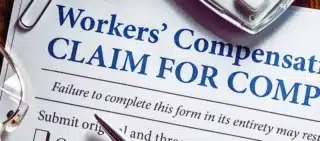
Common Reasons an Employer Won't Report Your Work Injury A total of 101,400 non-fatal work-related injuries and illnesses occurred in...


The workers’ compensation payout for PTSD will cover most associated expenses for the employee. Workers’ compensation refers to benefits you may recover to aid with medical expenses and other financial charges you may incur if you are injured while working.
Workers’ compensation takes away an employee’s ability to sue their employer. If there was no third party responsible for the injury, the victim’s only source of recovery is a worker’s compensation claim. If there were a contractor or subcontractor who was responsible for the injury, there would be the ability to sue the third party. This ability to sue would be through a separate personal injury claim.

Like other on-the-job injuries, workers’ compensation covers some mental health disorders brought on by your job duties. The benefits you receive and the total payout of your workers’ compensation claim will depend on several factors. For example, you may receive temporary wage replacement benefits if you cannot work for an extended period of time. If you are able to keep working while recovering from your injury, however, your benefits will likely not cover lost or reduced wages.
Rather than paying lump sum settlements for medical costs, your employer’s workers’ compensation insurer will issue direct payouts to the healthcare providers and treatment centers. It will work, for example, similar to receiving medical care using your private health insurance policy.
The costs of appealing a denied claim and obtaining legal representation may also impact your total workers’ compensation payout for PTSD.
Post-traumatic stress disorder, PTSD, is a common mental illness to suffer from. This is a mental health issue that can be triggered by certain tasks at work or meetings or meeting areas. The triggers come from repeated traumatic events or situations. According to the U.S. Department of Veterans Affairs, approximately 6% of people in the U.S. live with post-traumatic stress disorder. Women may have an increased likelihood of experiencing this type of mental disorder as compared to men.
It is common to have anxiety or problems managing stress. Those with post-traumatic distress disorder, however, may struggle to control these effects.
Experiencing stress as a result of your job pressures is not unusual. Acute stress, however, such as feeling overwhelmed by the tasks or discomfort in dealing with a co-worker, do not reach the level of post-traumatic stress disorder. Even experiencing a traumatic event does not always cause PTSD. Rather, acute stress may resolve within four weeks, while the symptoms and effects of post-traumatic stress disorder typically last much longer.
To diagnose post-traumatic stress disorder, your doctor will perform a thorough examination. To this end, he or she will likely check for physical medical issues that may be causing your symptoms. For instance, increased heart rate may seem the result of a near-death experience at work. In actuality, however, it may be caused by an underlying condition such as an overactive thyroid.
Your diagnosis will also include a psychological evaluation, or PTSD screen. To understand your mental state and the effect the traumatic work event had on you, your doctor may ask you a series of questions about your feelings, thoughts, and behaviors since the incident. Depending on varying factors, your healthcare provider may spend a short time with this evaluation, or up to two hours, to thoroughly examine your condition.
In conducting a PTSD screening, your doctor may use a structured interview, such as the clinician-administered PTSD scale or the structured clinical interview for DSM. Alternatively, they may ask you to self-report using a questionnaire with PTSD checklist that provides information regarding the severity and frequency of your symptoms.
Workers in varying fields may experience the type of trauma in the workplace. Some events that may cause employees this type of emotional distress include:
Prolonged stress can lead to symptoms which vary from person to person. Each individual can have different symptoms that may range from intrusive memories and avoidance to changes in arousal symptoms. You may experience manifestations such as scaring or frightening easily, difficulty sleeping, concentration issues, overwhelming shame or guilt, or irritability. Some with PTSD also display self-destructive behaviors.
Additionally, you may experience symptoms of distress that causes changes to your personality.
Other common symptoms of PTSD include:
Due to the effects of these symptoms, people may have issues in their personal and professional lives.
The symptoms you experience due to PTSD may impact all aspects of your daily life, including your ability to perform your work duties and earn a living for your family. Post-Traumatic Stress Disorder can affect relationships with people and co-workers. The workplace can cause these symptoms to arise, and the employee may not be able to function correctly at their job duties. Issues such as flashbacks, emotional outbursts, and absenteeism can be caused by factors that can happen while working.
You will work with your healthcare provider to develop a treatment plan that suits your unique situation and needs. Typically, such plans will include psychotherapy, medication, or a combination of them. The treatment program you develop will aim to help you address your symptoms by teaching you coping skills, helping you to adjust your view of yourself and the world around you, and treating the secondary issues resulting from PTSD.
Psychotherapy, or talk therapy, is used to treat both children and adults. It may include treatments such as cognitive therapy, exposure therapy or eye movement desensitization and reprocessing.
Cognitive therapy includes talking to help you recognize thinking patterns that are preventing you from moving past the trauma. Exposure therapy may involve the use of virtual reality or other programs to allow you to relive the traumatic event in a safe setting, from which you may begin to address the issues it caused. Often, cognitive and exposure therapies are used in conjunction with one another in the treatment of PTSD and other mental health conditions.
Eye movement desensitization and reprocessing, commonly referred to as EMDR therapy, utilizes guided eye movements and exposure therapy. Guided by the adaptive information processing model, EMDR has those with PTSD focus on the direct traumatic memory, while receiving bilateral eye stimulation to help alleviate the symptoms.
Sometimes, psychotherapy alone is not enough to manage the symptoms of post-traumatic stress disorder. Based on your unique symptoms and circumstances, your doctor may also prescribe medications to help treat your condition. Antidepressants, antianxiety medications, and Prazosin are often prescribed to patients with PTSD. Antidepressants aid in the management of depression and anxiety, and may help improve sleep and concentration. Antianxiety medications may help limit the occurrence of or reduce the effects of anxiety or panic attacks.
Prazosin is used to help reduce nightmares in patients with post-traumatic stress disorder. Recent studies, however, have questioned its efficacy.
When you suffer a work-related injury, taking the appropriate steps will help ensure you receive the benefits you need and deserve. The first step you should take is to obtain medical attention. If the injury does not need immediate medical attention, a doctor appointment will be scheduled based on the injury and the needs of the employee.
Next, you will report your injury to your employer. Your employer will have specified reporting protocols, which should be available to you in your employee handbook or posted somewhere in your workplace. Once employers receive incident reports of worker injuries, they will submit them to the insurance companies.
The report will go under review by the workers’ compensation carrier to verify that there actually was a legitimate workplace injury, a caseworker will be assigned. It is important to speak with an attorney prior to giving any statements to the caseworker or adjuster handling the file.
A claim’s adjuster assigned to your case will help determine doctor appointments and follow-up care. The adjuster works with the medical doctor to approve appointments. If additional treatment is needed, the adjuster will review doctor’s notes and summary visits to determine if it is approved. The additional care may fall under physical therapy, treatments or surgery. It is largely all based on the adjuster’s review of the medical chart.
If your claim for workers’ comp benefits is approved, you may be entitled to several types of benefits. Your employer’s workers’ compensation policy will cover your reasonable medical bills, as well as provide temporary or permanent disability benefits.
Once the adjuster signs off on medical expenses, it is not the employee’s responsibility. The wages are covered at 66 2/3% of normal wages. This allows for the employee to receive payment without working until reaching maximum medical improvement. With all medical expenses covered, this should help alleviate any stress for the employee.
Wage replacement benefits generally apply if you miss at least three days of work. In the event your injury requires you to miss more than 14 days of work, then you will receive replacement wages for those days.
Workman’s compensation is in charge of an employee returning to work. There may be a need for a lesser schedule, reduced productivity requirements, a new schedule altogether. Some injuries require an entire overhaul of the employee’s performance or ability to do their job. It may take the adjuster stepping in and modifying an employee’s tasks. This can lead to cut wages or decreased working hours. The adjuster will compensate for that. The purpose of workman’s compensation is to protect the employer and employee. Again, if an injury occurred at work, it is best to speak with an attorney who is experienced in workman’s compensation.
If an employee is able to return to work, it could be on limited duty and the employer should work with the constrictions given by the medical staff and adjuster. If the position is no longer available or the employee cannot work a normal schedule, there are retraining options. The employer may have to pay to allow the employee to learn a new task or position. Additionally, they may be required to cross train the employee to allow them to remain employed. It is up to the employer to find a position for the employee to work.
If an employee is unfortunately killed on the job, then the benefits go to the surviving spouse and dependents. There will still be an adjuster assigned to the case and an investigation. If there is a third party involved in the accident, then a separate lawsuit can be brought forward. It is important to hire an attorney if this situation occurs. It is in the best interest of the family to ensure all protocols are met.
It is a good idea to hire an attorney that focuses on workers’ compensation cases to ensure they are familiar with the law. The workers’ compensation lawyer will allow for communication to go through them, relieving some of the stress of having to deal with an adjuster directly. The attorney will take the case with no upfront costs to the employee or the employee’s family. The percentage taken after the case is settled is 20%.
The benefits of hiring an experienced attorney are deadlines will be met as well as certain documents that need to be filed will be, and the employee also has a direct line of communication for any questions or concerns. This can eliminate having to work directly with the adjuster and potentially saying something that might hurt the case and affect your workers’ compensation payout for PTSD.

Common Reasons an Employer Won't Report Your Work Injury A total of 101,400 non-fatal work-related injuries and illnesses occurred in...

At Strong Law Offices, we have a team of workers' compensation lawyers who understand the financial setbacks and physical limitations...

Common Equipment Involved in Run-Over Accidents Illinois job sites, from construction zones to industrial plants, depend on machinery to stay...